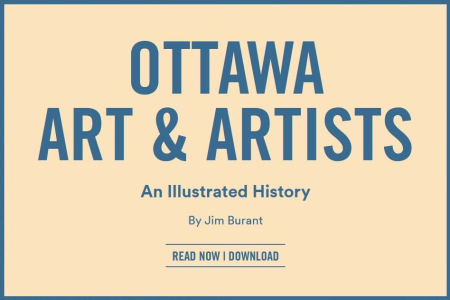On April 26, 2023, Jim Burant led us on a brisk virtual walk through the history of art in the Ottawa area. Jim was an Adjunct Professor of Art History at Carleton University as well as the Director of the Ontario Region of the National Archival Appraisal Board of Canada. He is a member of the Algonquins of Pikwakanagan, the co-curator of three major exhibitions of Ottawa art at the Ottawa Art Gallery and author of the recently published digital book, Ottawa Art & Artists: An Illustrated History, for the Art Canada Institute, with whom we were pleased to partner for this presentation. His book is the first in a series planned by the Art Canada Institute which will focus on art from a particular community in Canada. Jim pointed out that this will partially fill a gap in our understanding of art in Canada, as the two major references, Painting in Canada: A History by John Russell Harper and A Concise History of Canadian Painting by Dennis Reid, primarily reflect the work done in Montreal, Toronto, and Vancouver, making no mention of Ottawa.
Jim started us in the distant past, showing us the rock art of Mazinaw Rock in Bon Echo Provincial Park and the 77 pictographs of Oiseau Rock, many of which have been defaced by graffiti. This damage to sacred sites demonstrates a shocking disrespect for the culture and history of our Indigenous peoples. Jim explained that Indigenous artists have a long tradition of creating artifacts of cultural interest and worth. They worked with a variety of forms and materials, including baskets, copper and silver, ceramics and clothing, such as moccasins. Jim showed us a jacket made for him by his grandmother in 1969, which he still proudly possesses.
The arrival of European colonists resulted in the production of thousands of pieces of settler art that document their history. By showing us different works of similar subjects produced by different artists, Jim pointed out the importance of understanding the who, what, when, where, and why of a work’s creation, as they may have a very different take-away depending on the artist’s intent. These early works tell us a lot about Ottawa’s past as a lumbering and small industrial centre, an aspect of our city that has now vanished.
Jim explained that the selection of Ottawa as the capital in 1857 changed the nature of its art. There was an influx of artists into the city seeking patronage and employment or to teach at such organizations as the University of Ottawa and the Ottawa School of Art. There was, however, a dichotomy created between Ottawa as the nation’s capital and Ottawa as a local community. This was reflected in the fact that local politicians were content to abandon the promotion and collection of art to federal authorities. Thus, it was not until 1988 that the Ottawa Art Gallery was founded. Jim showed us a number of works by artists of the late 1800s, with a special emphasis on the work of Franklin Brownell, who Jim remarked to be his favourite.
The first half of the 20th Century brought massive changes to Ottawa. Spurred by two World Wars, there was a tremendous growth in the public service and public institutions leading to more opportunities for employment for artists and for them to display their works. Many artists found war work creating pamphlets, posters, maps and manuals. The National Film Board employed many notable artists at this time. Jim also pointed out that many well-known artists including Florence McGillivray, Fred Varley and Pegi Nicol MacLeod, who are not generally associated with Ottawa, did spend parts of their careers working here.
The second half of the 20th Century saw further developments to support the growing art community within Ottawa. These included the creation of art schools, such as the Algonquin College Art School and the Visual Arts Department of the University of Ottawa. Artists continued gathering as groups to work and exhibit together and to lobby for the creation of a municipal art gallery. Artist controlled exhibition venues such as the SAW Gallery opened, as did commercial galleries, such as the Blue Barn and the Robertson Gallery, which was among the first to exhibit Inuit art. As well at this time, art collectors, such as O. J. Firestone became prominent.
Jim also discussed the development of photography within Ottawa, starting with William Topley who ran his own studio in Ottawa from the mid-1870s to 1923. Topley is likely best known for his thousands of portraits, but he was also an innovator and a founder of the Ottawa Camera Club. Later, Yousuf Karsh came to Ottawa in 1932 and opened his studio somewhat later. He became involved in the local photographic community and the Ottawa Little Theatre. His best known work, a portrait of Winston Churchill taken in December 1941 was used on the cover of Life magazine and made him world famous. He continued to work in Ottawa into the 1990s.
In the past few decades there has been increasing interest in the works of Indigenous artists, such as Barry Ace, Rosalie Favell, Ron Noganosh, and Annie Pootoogook. As Canada has become increasingly multi-cultural and inclusive, there has been a corresponding increase in interest in works of artists from diverse cultural backgrounds.
In his closing, Jim reminded us that art challenges our notion of ourselves and allows us to see alternative points of view as we all attempt to negotiate our place in today’s Canada.
You can obtain a free download of Jim’s fantastic book on the Art Canada Institute website.
You can also see a full recording of his presentation on the video section of the HSO website.






